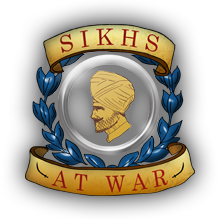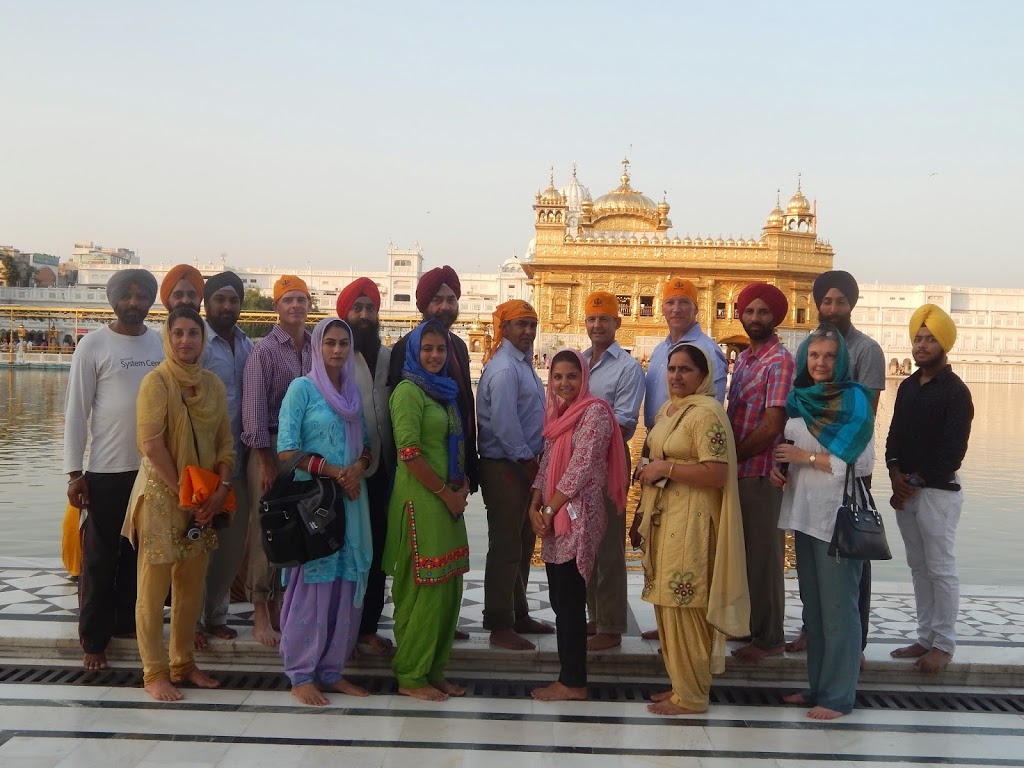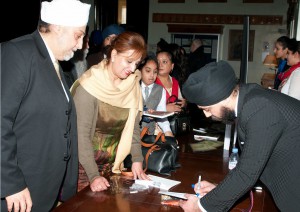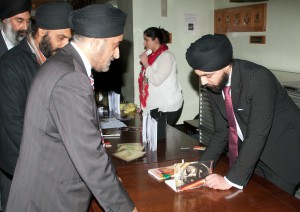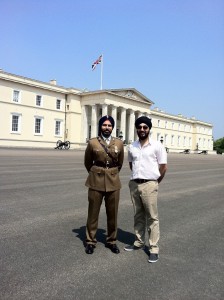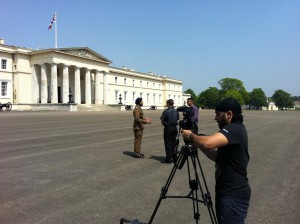Saragarhi Day At Sandhurst: A Review
2 CommentsOr, dare I say, that I would be stood infront of an audience of military and civilian personnel delivering a speech – then repeating a lighter version of it to school children, and another version to parents in Punjabi!
I didn’t even imagine that a delegation of serving British officers and soldiers (including Sikhs) would pay their respects at the memorial Gurdwaras built in it’s honour as well as at Sri Harimandir Sahib, Amritsar.
In 2014, that is what we have achieved.
The journey to narrate the true meaning and factual details of Saragarhi has seen the British Armed Forces re-embrace the battle as one which has a deep meaning within the UK, connecting Britain and Sikhs as well as shining a light on a period of frontier history often overlooked but highly relevant given the situation we face with jihadists.
Saragarhi Day has been a phenomenal event, seeing Sikhs and non-Sikhs, military and civillian, old and young, men and women coming together to mark an event that continues to inspire and encourage us all to dedicate ourselves to selfless and public service. The image at the top of this post shows you just how many people enjoyed the most English of settings.
The day began, for me, with picking up a rather special guest. A friend I made from Stockholm through my work on British-Sikh history who flew in especially to attend the event. Per Haaglund (I know he will appreciate this mention) was the proverbial excited kid in the candy store, through whom I got to see just how this heritage we occasionally take for granted is such an awesome sight for others.
 Technical set up and rehearsals followed, the excellent and professional “Your Army” team had everything in hand and were brilliant at ensuring a smooth operation with the various elements of video and sound being played.
Technical set up and rehearsals followed, the excellent and professional “Your Army” team had everything in hand and were brilliant at ensuring a smooth operation with the various elements of video and sound being played.
 As the audience filled in, a flutter came over me. But sat with my wife, I couldn’t help but feel that this was all very comfortable and feeling right. Not out of place nor nervousness, but rather excitement at being able to be a part of such an historic moment – a Saragarhi lecture on Saragarhi battle honour day! Major-General Robert Nitsch (GOC Support Command) proceeded me and was wonderful to speak to.
As the audience filled in, a flutter came over me. But sat with my wife, I couldn’t help but feel that this was all very comfortable and feeling right. Not out of place nor nervousness, but rather excitement at being able to be a part of such an historic moment – a Saragarhi lecture on Saragarhi battle honour day! Major-General Robert Nitsch (GOC Support Command) proceeded me and was wonderful to speak to.
My speech, I felt, was well received. I will endeavour to make another post of it. The atmosphere of the room was emotive, lights dimmed room packed with people, it lent itself nicely to the themes of my speech and the feelings I wanted to evoke. Lord Suri read a tribute poem (watch it here) I had discovered during research, which was a fitting way to lead into a minutes silence – which we encouraged via Twitter for others to observe at 1130. A jaikara/war cry broke the short moment of reflection before I continued on.
But I was disappointed (in all honesty) to later hear Lord Indarjit Singh rehash the same wikipedia factual inaccuracies I have researched and spent so long to dispell. (That UNESCO had ranked the battle, that Parliament gave a standing ovation).
After the speech, I hurried to the theatre room to speak to school children from Khalsa Primary, Slough about the battle and history (left). They had watched my film Indians in the Trenches, and were excited. Looking up at the podium I realised I would have to, off the cuff, water down some of the more gory bits for the group of 10 and 11 year olds! I laughed about this with the headteacher later. The kids were wonderful, and inquisitively asked some rather interesting questions which made this a pleasure.
I was then requested to do the same to a group of Punjabi parents – the families of the 1914 Sikhs troop, but in Panjabi! Looking once again upon my speech I adjusted to deliver it from English to Panjabi. Not an easy task but once again enjoyable given the people who had come to discover and see this history.
A break followed during which Punjab Restaurant Covent Garden provided a fantastic vegetarian lunch. The last event to mark Saragarhi on it’s battle honour day was a luncheon in 1947, so to see the officers mess filled with the smell of Indian food was amazing.
The day ended with everyone being led outside for a parade by 1914 Sikhs (left) a troop of young Sikhs from the Midlands who were equally impassioned about rekindling the spirit of their forefathers. They wore their turbans and period uniforms proud, shouted the jaikara loud – and never recited Gurbani/Sikh prayers which was stirring and inspiring.
The event ended with media interviews, briefing the BBC on factual details and nudging the right people in front of the cameras.
The immense positive nature of the day, the engagement with the community and between civilians and military was fantastic. But there were some shenanigans as one unsavoury character provided some scorn in attempting to hustle in on the event for his own purposes (Google search “Harbinder Rana”).
Nonetheless, the day ended with a lot of positive and a lot of enthusiasm at the historic occasion.
Here, I would like to turn my attention to another element of the day – indeed the week. For while we were commemorating the battle honour day at Sandhurst, a group of serving British Army personnel under the command of Brigadier Mark Abraham had spent the week marking Saragarhi in India.
The group visited the Saragarhi Memorial Gurdwaras in Amritsar, Ferozepur and to Fateh Academy. They had paid their respects at the holiest of Sikh sites, Sri Harimandir Sahib (above), and engaged with Sikh leaders.
As we begin to descend from the high of achieving such a remarkable and memorable event programme, I reflected to Lt Col John Kendall, who has been instrumental in seeing the potential for Saragarhi to reconnect the British and Sikhs, that this event had been ten times bigger and better than the one we ran in 2013.
The challenge for us now to continue to mark Saragarhi Day – and to continue to inspire people from all backgrounds to engage with the Armed Forces, involve themselves in public life and to be inspired!
